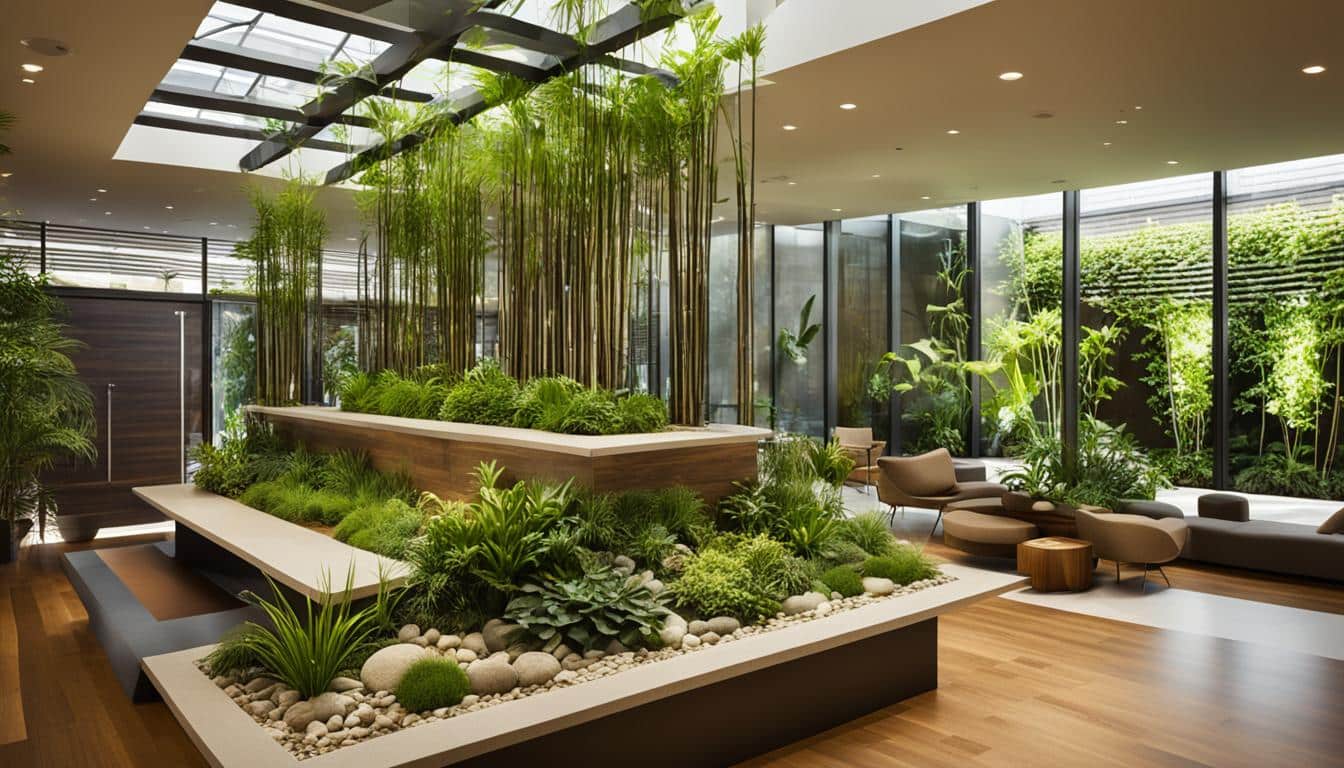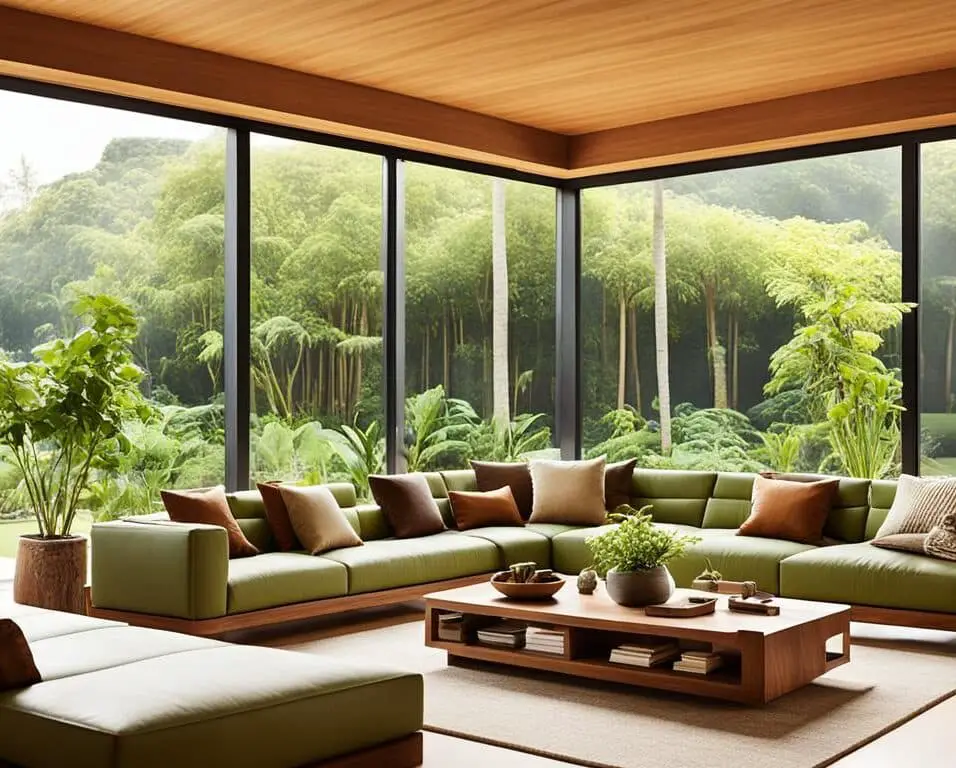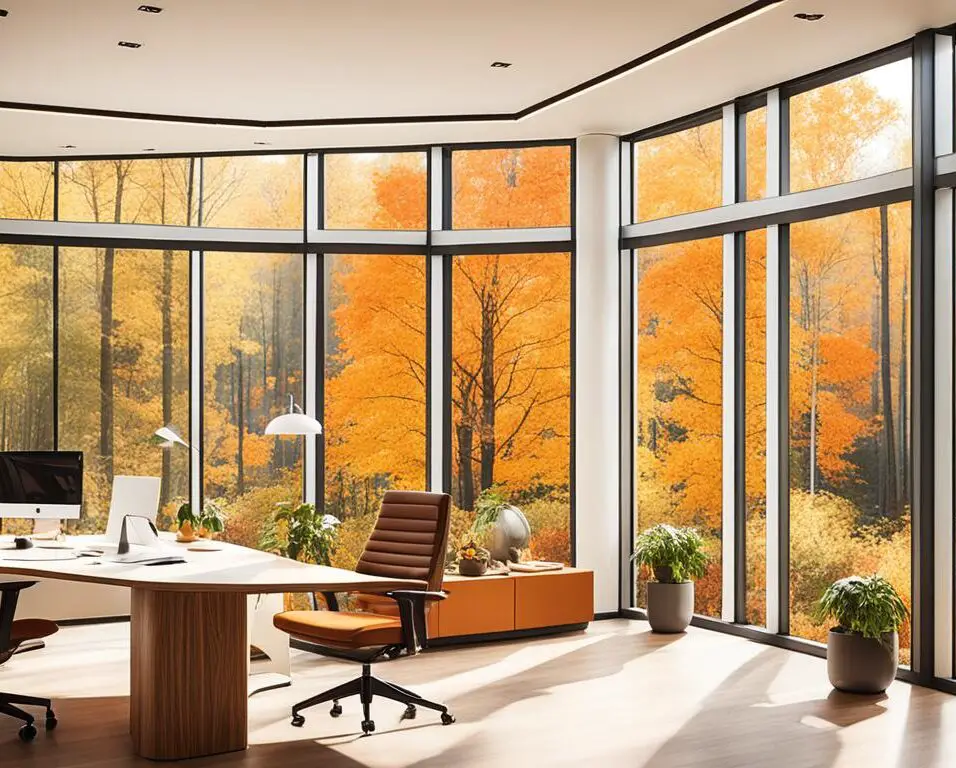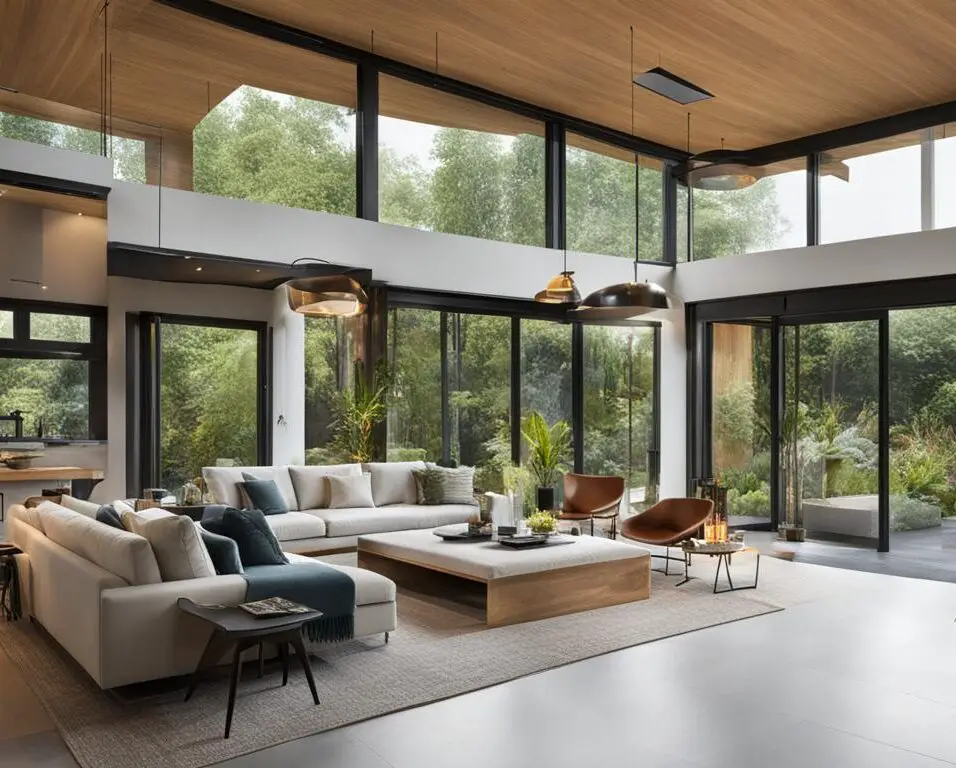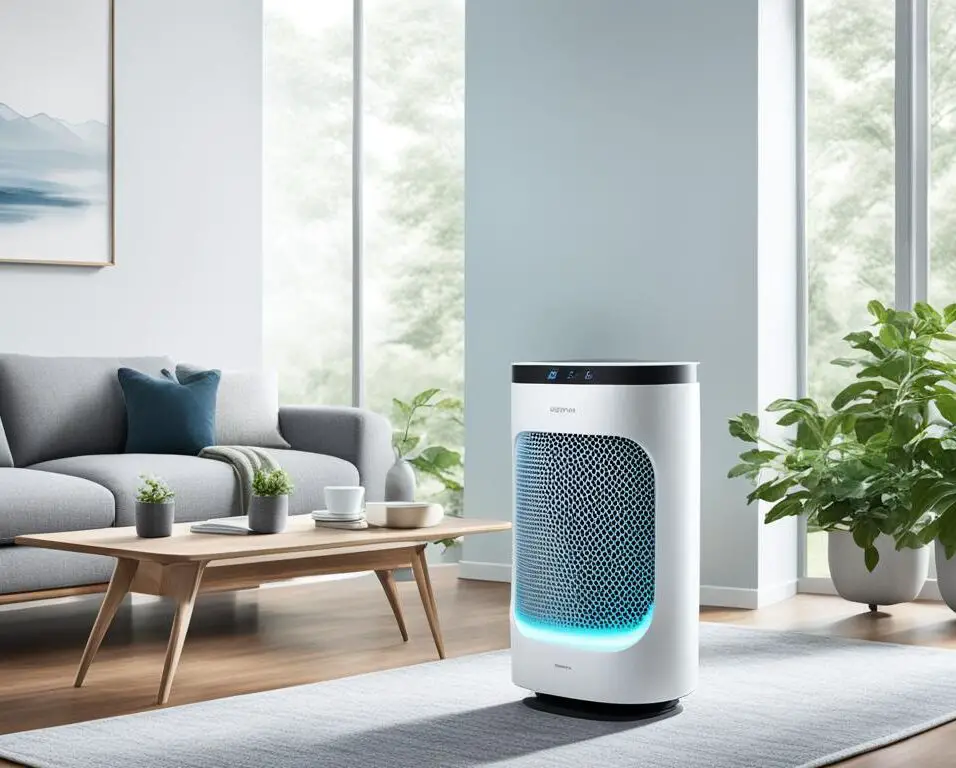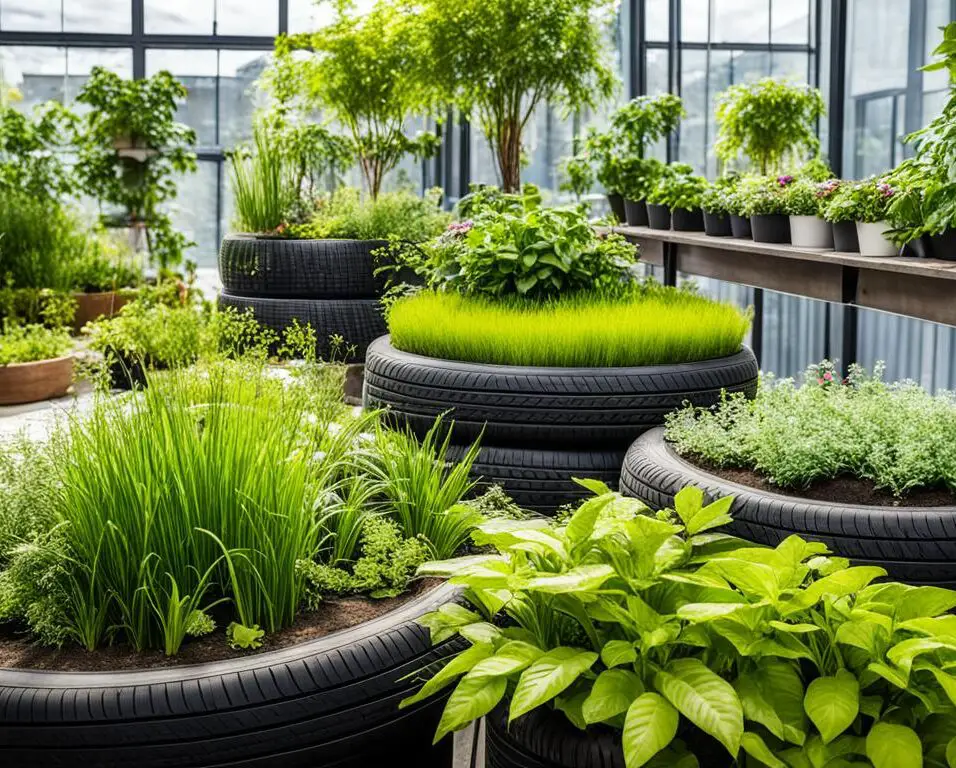Trends to Watch: Biophilic Design in 2024
As a professional copywriting journalist, I am excited to dive into the trends that will shape the world of biophilic design in 2024. Biophilic design, which emphasizes the connection between humans and nature in the built environment, is expected to gain even more popularity and influence in the coming year.
This design philosophy promotes the integration of natural elements, such as plants, natural light, and organic materials, into indoor spaces. By bringing nature indoors, biophilic design enhances well-being, productivity, and sustainability. It has been recognized for its positive impact on mental health, overall quality of life, and the environment.
In this article, we will explore the latest developments in biophilic design and how it is being implemented in diverse projects worldwide. From office spaces to modern homes, we will showcase inspiring examples that demonstrate the transformative power of integrating nature into our built environments.
Key Takeaways:
- Biophilic design is expected to grow in popularity and influence in 2024.
- It focuses on integrating natural elements into indoor spaces for improved well-being and sustainability.
- Biophilic design has been recognized for its positive impact on mental health, productivity, and quality of life.
- Projects like LinkedIn’s office expansion in Singapore and modern 800 sq. ft. house designs showcase the successful implementation of biophilic design principles.
- Innovative construction techniques, such as prefabrication and 3D printing, can be combined with biophilic design to create rapid and cost-effective projects.
Singapore Office Expansion Embraces Biophilic Design
The office expansion of LinkedIn Headquarters in Singapore, designed by SCA Design, exemplifies the incorporation of biophilic elements. Inspired by the vibrancy and commonality of the district, the design aims to “bring the outside in” by integrating outdoor materials and representing contemporary Singapore through commissioned artwork and iconic bridges used as room names. This project has received recognition and awards for its innovative biophilic design approach.
“Bringing the outside in” is the core concept behind the LinkedIn office expansion in Singapore. SCA Design, responsible for the project, sought to create an environment that not only highlights the natural surroundings but also pays tribute to the local culture. The incorporation of biophilic elements allows employees and visitors to connect with nature, promoting a sense of well-being and enhancing creativity.
One standout feature is the extensive use of outdoor materials throughout the office space. Natural wood, stone, and greenery create a seamless transition between the interior and exterior, blurring the boundaries and fostering a sense of harmony. The biophilic design elements not only contribute to the aesthetics but also serve functional purposes. Large windows bring in an abundance of natural light, reducing the dependency on artificial lighting and improving energy efficiency.
“The integration of biophilic design principles creates a calming and inspiring work environment. Employees can enjoy the benefits of nature without leaving the office, boosting their creativity and productivity.”
Artistic representation of Singapore
To further immerse visitors and employees in the essence of Singapore, commissioned artwork that reflects the city’s characteristics adorns the office walls. These captivating pieces serve as visual representations of Singapore’s landscape, culture, and identity, adding a layer of authenticity to the overall design.
In addition, the office expansion incorporates iconic bridges as room names, paying homage to Singapore’s architectural landmarks. This creative approach not only adds a visual interest but also showcases the city’s distinctive architectural heritage.
The LinkedIn office expansion in Singapore has garnered recognition and awards for its innovative biophilic design approach. Combining nature-inspired elements, local artwork, and architectural references, the design successfully creates a dynamic and refreshing work environment that promotes well-being, productivity, and a strong connection to the vibrant city of Singapore.
Modern 800 Sq. Ft. House Design and Biophilic Elements
In the realm of modern architectural trends, the integration of biophilic elements in 800 sq. ft. house designs has gained significant recognition. These innovative designs prioritize a harmonious connection with nature, creating spaces that promote well-being and sustainability.
One prominent feature of these modern house designs is the incorporation of large windows. These expansive openings allow an abundance of natural light to flood the interior, creating a bright and uplifting atmosphere. Not only do these windows enhance the visual appeal of the space, but they also provide ample ventilation, bringing the freshness of the outdoors indoors.
Another key aspect of biophilic design in 800 sq. ft. houses lies in the use of natural materials. Materials such as wood and stone bring a sense of warmth and authenticity to the space, while also establishing a deeper connection to the natural world. The presence of these natural elements further enhances the biophilic design, adding an organic touch that resonates with our innate affinity for nature.
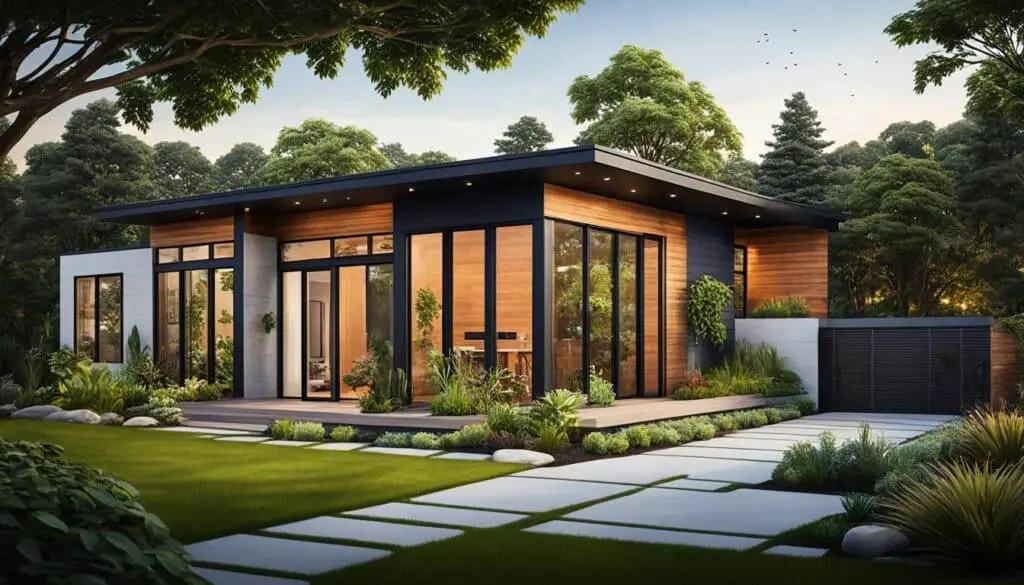
“The integration of biophilic elements in modern 800 sq. ft. house designs creates a sense of unity with the surrounding environment, fostering a sense of well-being and tranquility.” – Architect Jane Williams
Innovative Construction Techniques for Biophilic Design
When it comes to fast construction, the world of biophilic design offers several innovative techniques that can revolutionize the industry. By leveraging cutting-edge methods such as prefabrication, 3D printing, and automated construction, biophilic design projects can benefit from accelerated timelines, cost-effectiveness, and improved quality control.
Prefabrication and modular construction have gained popularity due to their ability to streamline construction processes. With prefabrication, building components are manufactured off-site in controlled environments before being transported and assembled on-site. This approach significantly reduces construction time and minimizes waste, making it an ideal choice for biophilic design projects.
3D printing is another groundbreaking technology that holds tremendous potential for biophilic design. By using specialized printers, it is possible to create intricate and customized structures with precision and efficiency. This technique allows for the implementation of complex biophilic elements, such as organic shapes and patterns, that seamlessly integrate nature into the built environment.
Automated construction, leveraging robotics and artificial intelligence, is also revolutionizing the construction industry. By automating repetitive and labor-intensive tasks, construction processes become faster and more accurate. The use of automation in biophilic design projects ensures precision in the implementation of natural elements and reduces the risk of human error.
But it’s not just about speed and efficiency. Green building practices are essential in biophilic design projects to promote sustainability and minimize environmental impact. Incorporating recycled and locally sourced materials reduces the carbon footprint of the construction process. Energy-efficient technologies, such as smart lighting systems and HVAC systems, optimize energy consumption. Furthermore, the integration of smart technologies, such as sensors for natural light and temperature control, enhances the overall sustainability of biophilic design projects.
By embracing these innovative construction techniques and green building practices, biophilic design projects can create harmonious environments that prioritize the well-being of occupants while honoring the natural world.
Here is an example of how these techniques can be utilized in a biophilic design project:
| Construction Technique | Advantages |
|---|---|
| Prefabrication and Modular Construction |
|
| 3D Printing |
|
| Automated Construction |
|
| Green Building Practices |
|
By leveraging these innovative construction techniques and incorporating green building practices, biophilic design can truly flourish, creating spaces that enhance well-being, sustainability, and human connection to nature.
The Benefits of Rapid and Cost-Effective Construction
Rapid construction and cost-effective construction methods offer a plethora of advantages to projects in terms of efficiency, quality, and sustainability. By embracing innovative construction techniques and incorporating biophilic design principles, we can deliver outstanding results without compromising on time or budget.
Let’s explore some of the key benefits of rapid and cost-effective construction:
Shorter Project Timelines
Rapid construction methods enable projects to be completed in significantly shorter time frames compared to traditional construction methods. By streamlining processes and leveraging advanced technologies like prefabrication and automation, construction timelines can be expedited without compromising structural integrity or design aesthetics.
Reduced Labor Costs
Cost-effective construction techniques often rely on streamlined processes and the use of prefabricated components, reducing the need for extensive on-site labor. This not only minimizes labor costs but also enhances efficiency and reduces the risk of delays associated with workforce availability.
Improved Quality Control
Rapid construction techniques usually involve the use of standardized and factory-controlled manufacturing processes. This results in enhanced quality control, as the components are produced under controlled conditions with rigorous testing and inspections. Implementing quality assurance measures from the early stages of construction ensures a consistently high level of quality throughout the project.
Minimized Environmental Impact
Incorporating rapid construction methods often promotes sustainable practices and reduces the environmental impact of construction projects. By utilizing energy-efficient technologies, recycled materials, and minimizing construction waste, these methods contribute to a more eco-friendly approach to construction and align with the principles of biophilic design.
By combining the benefits of rapid and cost-effective construction techniques with the integration of biophilic design principles, we can create spaces that prioritize human well-being, sustainability, and connection with nature. The image below visually represents the harmony between rapid construction and biophilic design:
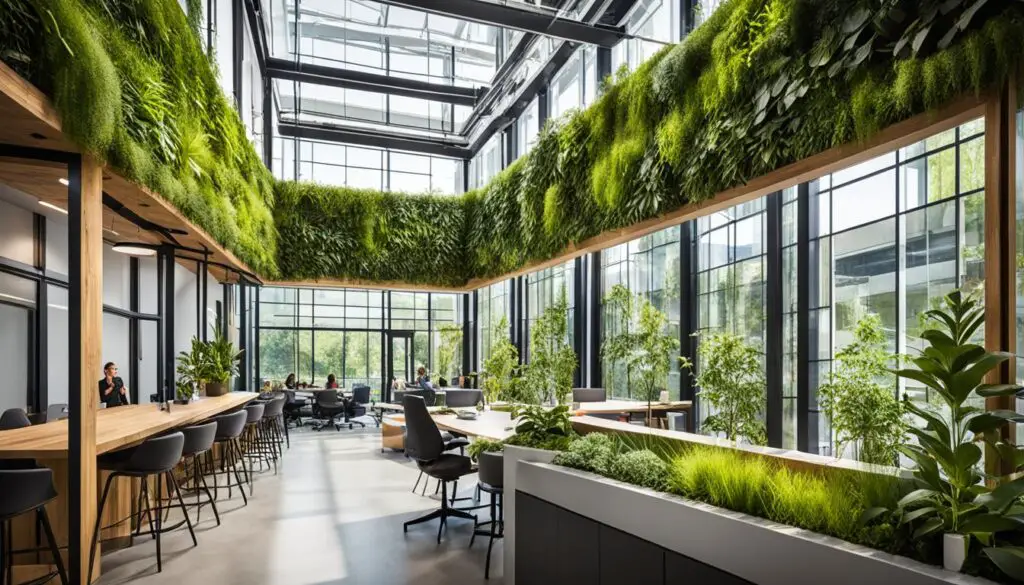
As seen in the image, the use of prefabricated materials and the integration of natural elements create an environment that fosters well-being while reducing construction time and costs.
In summary, rapid and cost-effective construction methods not only accelerate project timelines and reduce costs but also deliver exceptional quality and minimize the environmental impact. By embracing these techniques alongside biophilic design principles, we can create sustainable and inspiring spaces that improve our well-being and connection with nature.
The Future of Biophilic Design and Construction
As we look ahead, it is clear that the future of biophilic design and construction lies in finding even more efficient and sustainable methods. Advancements in technology, such as artificial intelligence and robotics, are expected to play a significant role in streamlining construction processes and enhancing the integration of biophilic design principles.
Artificial intelligence can be leveraged to optimize energy usage, monitor and control indoor air quality, and automate building maintenance. By utilizing sensor data and machine learning algorithms, buildings can adapt to occupants’ needs, creating personalized and comfortable environments that enhance well-being.
“The integration of artificial intelligence in the construction industry has the potential to revolutionize how we design and build our spaces. It allows for more precise planning, faster construction timelines, and improved sustainability.” – John Lee, Architect and AI Expert
Robotic technologies are also expected to transform the construction industry by automating labor-intensive tasks and improving site safety. Robots can assist in assembling and installing biophilic elements, such as green walls and solar panels, with precision and efficiency.
Emphasis on Sustainability and Renewable Energy
In addition to technological advancements, there will likely be an increased emphasis on sustainability and the use of renewable energy sources in biophilic design and construction. Buildings will incorporate renewable energy systems, such as solar panels and wind turbines, to reduce their environmental impact and reliance on non-renewable energy sources.
Furthermore, sustainable materials and construction practices will continue to be prioritized to reduce waste and emission in the construction process. This includes utilizing recycled materials, promoting circular economy principles, and implementing green building certifications like LEED (Leadership in Energy and Environmental Design).
The Rise of Smart Cities
The future of biophilic design and construction is closely intertwined with the development of smart cities. These cities leverage technology and data to optimize energy usage, improve infrastructure, and enhance the well-being of their inhabitants. Biophilic design principles will be integrated into the planning and development of smart cities to create urban environments that prioritize human connection with nature.
Smart city initiatives may include the creation of urban parks, rooftop gardens, and green transportation systems to maximize access to green spaces and reduce carbon emissions. These initiatives align with the goals of biophilic design and contribute to the overall well-being of city dwellers.
| Key Trends for the Future of Biophilic Design and Construction | How It Impacts Biophilic Design and Construction |
|---|---|
| Integration of artificial intelligence and robotics | Efficient planning, faster construction timelines, enhanced occupant comfort |
| Focus on sustainability and renewable energy | Reduction in environmental impact, improved energy efficiency |
| Development of smart cities | Optimized urban environments, increased access to green spaces |
In conclusion, the future of biophilic design and construction is poised for exciting advancements. Through the integration of cutting-edge technologies, a stronger focus on sustainability, and the development of smart cities, we can create built environments that promote well-being, harmony with nature, and a more sustainable future.
Conclusion
Biophilic design is a powerful trend that is revolutionizing the way we approach the design and construction of our built environments. By embracing the principles of biophilia and incorporating innovative construction techniques, we have the opportunity to create spaces that not only enhance our well-being but also contribute to a more sustainable future.
As we look ahead to 2024 and beyond, biophilic design and rapid, cost-effective construction methods will continue to shape the architecture and construction industries. This integration allows us to prioritize nature and human connection, creating environments that foster both productivity and a deep sense of harmony with the natural world.
With the growing recognition of the benefits of biophilic design, we are witnessing an exciting time for those who are passionate about creating spaces that embrace and celebrate nature. As we move forward, advancements in technology, such as artificial intelligence and robotics, will play a significant role in further streamlining construction processes and enhancing the integration of biophilic design principles. Additionally, the development of smart cities and the increased use of renewable energy sources will further contribute to the sustainability and well-being of our built environments.
In conclusion, biophilic design offers endless possibilities for creating spaces that prioritize our connection to nature. By embracing the principles of biophilia and incorporating innovative construction techniques, we can build a more sustainable and harmonious future for all.
FAQ
What is biophilic design?
Biophilic design is an architectural approach that emphasizes the connection between humans and nature in the built environment. It involves integrating natural elements, such as plants, natural light, and organic materials, into indoor spaces to enhance well-being and sustainability.
Why is biophilic design growing in popularity?
Biophilic design is expected to continue growing in popularity in 2024 due to the increasing recognition of its benefits. It has been found to improve mental health, productivity, and overall quality of life. People are now realizing the importance of incorporating nature into our indoor spaces.
Can you give an example of biophilic design in action?
Certainly! The office expansion of LinkedIn Headquarters in Singapore, designed by SCA Design, is a great example of biophilic design. It “brings the outside in” by integrating outdoor materials, commissioned artwork, and iconic bridges used as room names. This project has received recognition and awards for its innovative biophilic design approach.
How can biophilic elements be incorporated into a modern house design?
Modern 800 sq. ft. house designs often embrace biophilic elements. Large windows allow natural light to flood the space, while also providing ventilation. The use of natural materials, such as wood and stone, further enhances the biophilic design, creating a home that promotes well-being and sustainability.
Are there any innovative construction techniques that can be applied to biophilic design?
Yes, there are several innovative construction techniques that can be applied to biophilic design. Prefabrication and modular construction, 3D printing, and automated construction methods offer accelerated timelines, cost-effectiveness, and improved quality control. Incorporating green building practices, such as the use of recycled and local materials, energy-efficient technologies, and smart technologies, further enhances the sustainability and cost-effectiveness of biophilic design projects.
What are the benefits of rapid and cost-effective construction?
Rapid and cost-effective construction methods offer numerous benefits, including shorter project timelines, reduced labor costs, improved quality control, and minimized environmental impact. By embracing these methods and incorporating biophilic design principles, projects can be completed more efficiently without compromising on quality or sustainability.
What does the future hold for biophilic design and construction?
The future of biophilic design and construction lies in finding more efficient and sustainable methods. Advancements in technology, such as artificial intelligence and robotics, are expected to streamline construction processes and enhance the integration of biophilic design principles. There will also likely be increased emphasis on renewable energy sources and the development of smart cities that prioritize well-being and sustainability.
Source Links
- https://globaldesignnews.com/considering-tomorrows-needs-sca-design-linkedin-office-expansion-focuses-on-bringing-the-outside-in-and-incorporating-local-elements-within-the-office-space/
- https://www.allinfohome.com/house-design/modern-house-design-800-sq-ft
- https://www.re-thinkingthefuture.com/architectural-community/a11968-architecture-trends-rapid-and-cost-effective-construction-methods/



